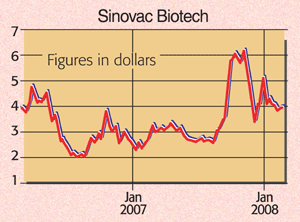
According to medical lore, the Spanish flu pandemic that swept the globe in 1918 struck down its victims almost in mid-stride. As Robin Marantz Henig puts it in his book Voyages Along the Viral Frontier, four women in a bridge group stayed up to play cards until 11 o’clock one evening. By the next morning, three of them were dead. A man who felt well enough to go to work that morning rode the streetcar for only six blocks before he died. In the single month of October 1918, more than 200,000 US citizens alone died from the mutating virus.
Of course, these days Americans can rely on sophisticated vaccines, reformulated each year to keep pace with new strains of the virus. But in China, where vast swathes of the population don’t have the luxury of a ready vaccine, the prospect of a devastating pandemic is very real. One aspect of the 1918 outbreak is especially worrying to the Chinese government: soaring population density as more and more people leave the countryside. With nearly 70% of the Chinese population expected to live in urban areas by 2035, keeping a lid on disease in the heaving slums that surround China’s major cities will demand an aggressive vaccination plan.
So it’s a good thing that China’s government is serious about building its defences against an influenza outbreak. The government invested $646m in an anti-epidemic system in 2005, more than in the previous five years combined. But China’s vaccine manufacturers still have a remarkable amount of work to do to keep their cities safe. According to the State Food and Drug Administration (SFDA), the current annual output of vaccines is only enough to protect around 500 million individuals. When you have a population of 1.32 billion, that’s a problem. With Beijing scribbling new prescriptions as fast as it can, the local vaccine market – currently worth $388m – is expected to grow to $1.9bn by 2010.
In fact, governments worldwide seem at last to be waking up to the scale of the pandemic threat, rousing a vaccine industry that has been virtually sleep-walking over the past decade. Manufacturers had been dropping out of the business for years as they struggled to turn a profit on cheap mass-produced vaccines, mainly for children. But with fears of bioterrorism arising in the wake of September 11th, and Bird Flu now seen as a major threat, both the US and the EU have been stocking up on adult vaccines, and influenza ones particularly. The entire industry is expected to grow at a 10.9% annual rate to top $31.3bn by 2013, says BCC Research. And despite their troubles keeping up with demand at home, Chinese vaccine makers are doing good business exporting their wares to these markets.
Yet world preparations for a pandemic remain inadequate, says disease expert Michael Osterholm of the University of Minnesota. The current state of affairs is “Like sending 10 troops to a war when you need 10,000,” he told the New York Times. The H3N8 strain of influenza found in horses in the 1960s took 40 years to jump species and pose a threat to humans, notes Osterholm. But the current H5N1 strain of Bird Flu is “the worst that has ever been known”, having already spread to 60 countries. Those governments overseeing rapidly urbanising societies face a ticking time bomb. In the box below, we have a look at one company helping them to defuse it.
Effective vaccines ensure Sinovac is in rude health
One firm profiting from both local and international markets for vaccines is Chinese biotech Sinovac (AMEX:SVA). The company is one of China’s leading providers of vaccinations and its profits are rising as it benefits from the Chinese government’s commitment to increase spending on the national immunisation programme. A new plant, built to manufacture a very promising Bird Flu vaccine that is close to approval, will produce 20 million doses of the vaccine annually.
Sinovac’s hepatitis vaccines are already selling well on global markets and its seasonal influenza vaccine has been given a new lease of life since Sinovac signed a promotion deal with UK-listed drug giant GlaxoSmithKline. The company recently announced a 266% increase in its third-quarter profits to $9.2m on the strength of sales of these vaccines.
Sinovac is valued on a forward p/e of 13, which would be reasonable for the sector in any case, but with a price-to-earnings growth ratio of just 0.5, Sinovac looks very cheap indeed for a company with such outstanding growth prospects, says Stanley Ng of Dutton Associates. Dutton has a 12-month target price of $7.50 on the stock, currently trading at $4.11.